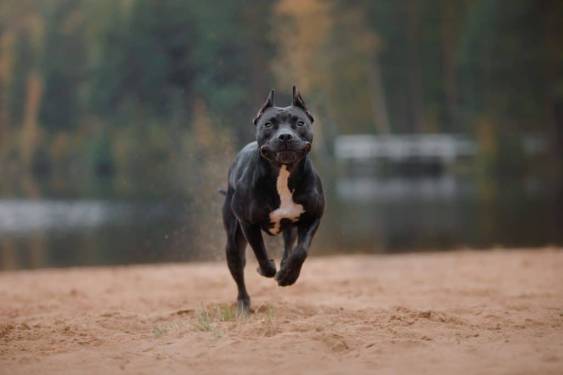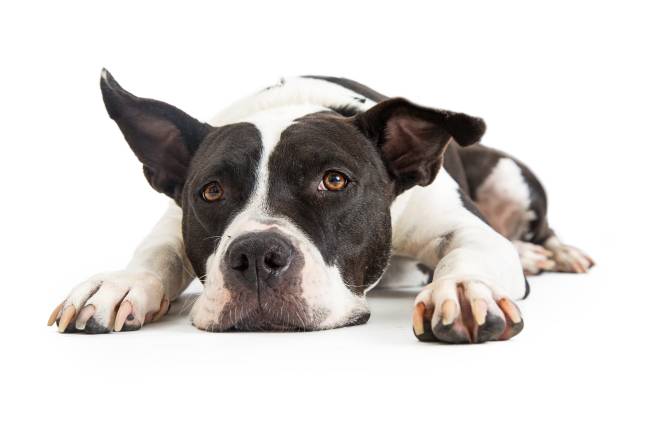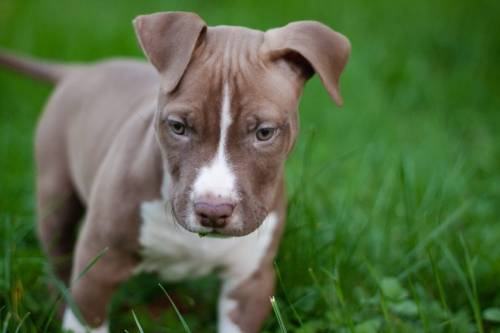Do you have a Pitbull? Would you like to learn about exercises to help your Pitbull build muscle? If so, then you’ve come to the right place!
Connect with a verified veterinarian in minutes. Licensed vets are available 24/7 to answer your questions. No need to worry about your furry family member.
We’ve put together some information on Pitbull activities that can build strong muscles. Let’s get started!
Food First
Before you even begin to train your dog, it’s necessary to start him off on a high-quality dog food. Food is the foundation of a healthy, strong dog. There’s no way around that fact.
This means you’ll need to avoid feeding your Pitbull a cheap dog food that has fillers. Fillers that aren’t healthy include corn, grain byproducts, and more. What your dog needs to build strength and muscles is plenty of high-quality protein.
Studies have shown that Pitbulls need to gain 70% to 90% of their energy from fat metabolism rather than carbs. So, your dog food will need to have plenty of fat, along with a higher caloric count per meal. The protein must be sourced from meat, not plants. And your dog will need plenty of vitamins and minerals when he’s exercising and building muscle.
Some of the best dog foods to help Pitbulls gain weight include:
High-Performance Super Premium Dog Food: this is a meat-based formula, which uses real meat as the #1 ingredient. In addition, this dog food has more calories than other formulas in the same category. This is a great food for adult dogs and puppies (4 weeks and older). You’ll also be happy to know this dog food has never been recalled.
Taste of the Wild Dry Dog Food with Roasted Bison and Roasted Venison: here’s a food with a taste of the wild! It contains real meat and plenty of protein for lean, strong muscles. The formula also contains vitamins and minerals, as well as antioxidants to support healthy skin and coat. The ingredients are sourced from trusted and sustainable sources around the world. This food contains no artificial flavors, colors, or preservatives, and it’s made in the USA.
Purina Pro Plan Sport: this is a dog food that helps Pitbulls put on weight. The #1 ingredient is real chicken. The formula contains 30% protein and 20% fat to help maintain lean muscle and meet metabolic needs.
So, be sure to start your canine companion on a healthy diet comprised of proteins and enough fat to help him gain weight and build strong muscles.
Obedience Training is a Must
Next, you’ll want to make sure your dog listens to you, which means he will need obedience training. Obedience training should start young when the dog is a puppy. You may even want to consider getting a professional trainer to work with you and your dog.
What does obedience include? All the basic cues such as stay, sit, come, heel, drop it, and more. These are crucial for your dog to learn before starting to exercise. Your dog needs to listen to you and respond correctly, which means he must have knowledge of basic cues.

Review symptoms, medications & behavior to keep your pets healthy with a Vet Online in just minutes.
Ask a Vet Live NowAvoid Long Hours of Cardio Exercise
When your dog is working hard to build muscles, avoid long hours of cardio activities. The reason is these activities burn muscle instead of building it. Rather than going all out for long cardio exercises, aim for short workouts of about 10-15 minutes a day.
Cardio exercises that put on muscle include high-intensity workouts such as sprinting, running up stairs, or hills for short periods. To take the work out to an even higher intensity, you may want to consider adding a weight vest to your dog’s exercise gear.
Rest & Recovery are Essential
Remember that your dog will need plenty of rest and recovery when building muscles. Hard exercise tears the muscle fiber, leading them to repair and grow.
However, they will need to rest and recover in order to rebuilt correctly. Without this rest and recovery cycle, your canine companion will not be able to gain muscle mass.
You might consider resting your dog every other day in order for his muscles to recover. On those rest days, it’s important to make sure your dog has plenty of rest and sleep.
Develop a Roadwork Plan
Now you’re ready to create a roadwork plan for your Pitbull! A roadwork plan is just a fancy name for an exercise plan that involves running with your dog or cycling as they run beside your bike. This is a great exercise for any dog who has plenty of energy and stamina.
Roadwork and running help to work the muscles as the dog moves. This makes individual muscle fibers grow and become stronger.
For this type of exercise, it’s best to go with a harness rather than a collar. The harness distributes pulling weight much better than a collar. Plus, you’ll have more control of your dog with a harness. You might consider this harness:
PoyPet No Pull Dog Harness: this is a no-pull, no choke harness that includes two sturdy metal leash attachment points. Plus, the no-choke design keeps pressure from building on your dog’s neck if he’s pulling. This is a harness that’s easy to put on and take off, with three quick-release buckles. The harness is made of nylon webbing with 3m reflective material to make sure your dog is easily seen in the early morning or late evening.
When you begin the roadwork with your fur baby, start out slowly. As he gains strength, add 30 minutes of jogging into your canine companion’s daily exercise routine. Work up to about an hour a day when your dog’s ready.
Spring Pole Training
Another way to help your dog build muscle is through the use of a spring pole. The spring pole is a piece of exercise equipment for dogs, which provides a great workout for building muscles in Pitbulls and other dogs.
You might try this one:
Dibbatu Spring Pole Dog Rope Toy: this spring pole includes 16ft of safety cord, which can be hung from a tree branch or wood beam under the deck. It can also be wrapped around a tree. Just loop it and pull it snug. The toy is made of rustproof stainless steel and can hold up to 300 lbs. This is a great muscle-building exercise for Pitbulls.
Consider a Dog Treadmill
Walking is a great way to warm your dog’s muscles for more intense workouts. While you can take him for a walk before training, a dog treadmill can also be helpful. With a treadmill, you can gradually get your dog to walk faster and eventually run on the treadmill.
You might consider this treadmill:
dogPACER LF 3.1 Folding Fitness Dog Treadmill: this treadmill can hold dogs up to 179lbs and is a great way to get your Pitbull warmed up before his more intense workouts. Even on a rainy day, your dog can take a walk and release pent-up energy! This treadmill is lightweight and portable, too.
Weighted Pulling
This is another type of exercise that can build muscles on your Pitbull! It’s an exercise that’s also a dog sport. For this exercise, you’ll need a weight pulling harness, as well as a weight such as a tire for the dog to pull.
It’s best to start out with a light amount of weight and then have your dog drag this about 10-20 meters. Let him rest a couple of minutes, and then repeat the process. Always start out easy and gradually increase the weight only as your dog gains strength.
Swimming
This is a great way to exercise your dog’s entire body! In fact, your fur baby can still gain muscle mass in the water, but without putting stress on his joints and bones. This is a low-impact exercise that your dog is sure to enjoy.
Stairs or Uphill Exercise
Stairs and uphill workouts are another great way to build muscles on a Pitbull. These activities work a wide range of muscle groups, including the core muscles.
Walking up stairs or a hill works to strengthen the dog’s rear legs. As they go down the stairs, dogs use their opposing muscles to gain stability.
Tug of War
The game of tug of war is much appreciated by most dogs. And it does work to build muscles on Pitbulls. As you play this game, get your dog to crouch and pull back.
Weighted Fetch
Fetch is another classic dog game many of us play with our dogs. In this version of the game, use an object that has some weight to it in keeping with your dog’s size. This could be a tire from a wheelbarrow or a plastic dumbbell. You could even use a water bottle filled with sand or water.
Weighted Backpack
Using a weighted backpack is another great way to build muscle on your Pitbull! Your fur baby can carry up to 10% of his body weight for a 10-minute walk. Not only does this build muscle, but it also wears off excess energy.
You might consider this weighted backpack:
XDOD Weight & Fitness Vest for Dogs: this weighted vest comes in a wide range of sizes, so you’re sure to find the right size for your Pitbull. The vest helps to build strength, grow strong muscles, and more. It’s safe and comfortable; the vest uses bags that can be filled with sand. This means the vest will conform to your dog’s body and not cause pressure points when he’s moving. The vest is made of high-quality, lightweight material that’s breathable. It’s also very durable.
There you have it! These are all methods you can use to help your Pitbull put on muscle. Plus, he’ll have fun using these tools as he workouts out!
Connect with a verified veterinarian in minutes. Licensed vets are available 24/7 to answer your questions. No need to worry about your furry family member.

Julie
Julie is a graduate of the University of North Carolina, Wilmington, where she studied Animal science. Though contrary to the opinion of her parents she was meant to study pharmacy, but she was in love with animals especially cats. Julie currently works in an animal research institute (NGO) in California and loves spending quality time with her little cat. She has the passion for making research about animals, how they survive, their way of life among others and publishes it. Julie is also happily married with two kids.
Review symptoms, medications & behavior to keep your pets healthy with a Vet Online in just minutes.
Ask a Vet Live Now



